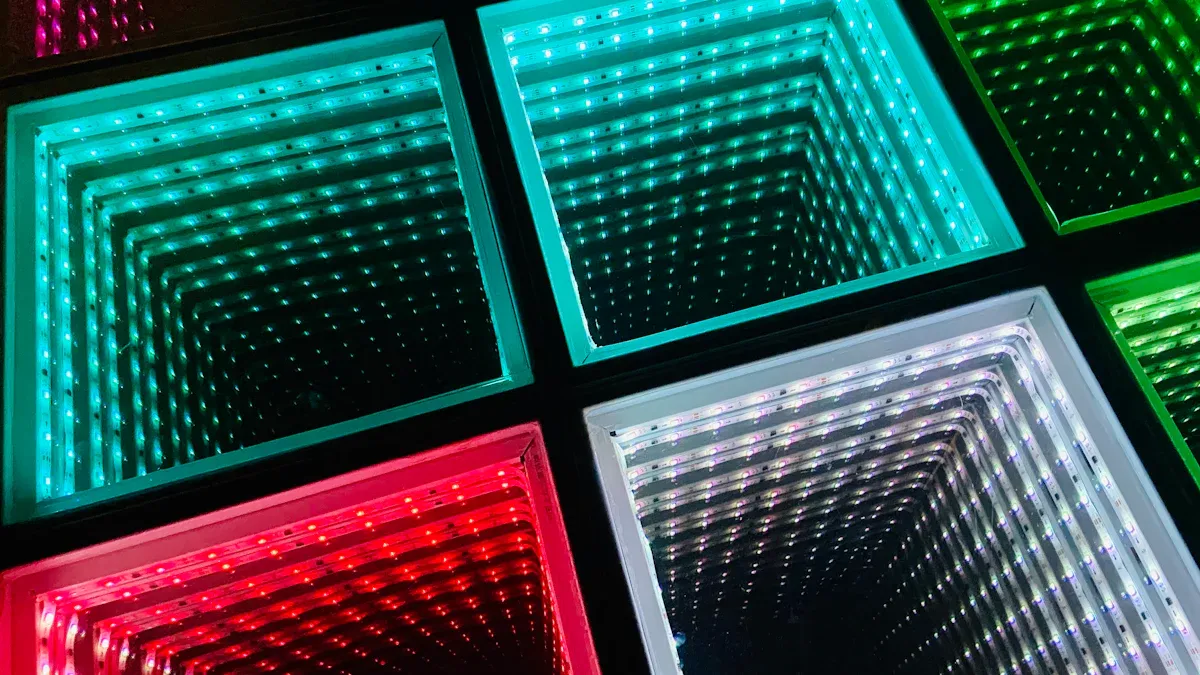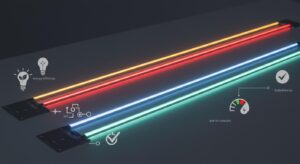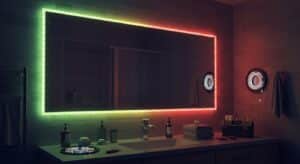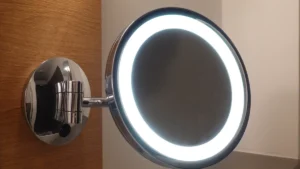
Choosing the best signage LED strip is very important for signs. Good signage LED strips are bright and make signs easy to see. They work well even in sunlight and save energy. This lowers costs and lasts up to 50,000 hours. That’s much longer than old-style lights. Signage LED strips come in different wattages, like 10-15 watts per meter. They also have brightness levels for different uses, like decoration or business displays. These strips are eco-friendly and don’t have harmful materials. This makes them a smart and green choice for signs today.
Key Takeaways
Pick bright LED strips for outdoor signs to see them in sunlight.
Choose a color temperature that fits your brand’s look and feel.
Make sure the LED strips have a good IP rating to resist dust and water outdoors.
Use energy-saving COB LED strips to lower costs and make your signs last longer.
Read supplier reviews and check warranties to get good products and help when needed.
Key Factors to Consider
Brightness and Visibility
The brightness of your signage LED strip is very important. It helps your sign stand out and be noticed. Brightness levels decide how well your sign shows in different lights. For example, outdoor signs in sunlight need brighter LEDs to stay visible. Indoor signs or dim areas can use softer lighting instead. This flexibility helps your sign look clear and easy to read anywhere.
To make signs more visible, use high-contrast colors. Bright colors on dark backgrounds catch attention fast. Lighting also affects how easy signs are to read. Outdoor signs need bright LEDs, while indoor ones can use medium brightness for balance.
Color Temperature and Options
Color temperature changes how your sign feels and looks. Warm white LEDs (2700K-3000K) feel cozy and welcoming. Cool white LEDs (5000K-6500K) look modern and professional. Colors also affect emotions, so pick ones that match your brand’s message.
Check the Color Rendering Index (CRI) when choosing LED strips. A high CRI shows colors more accurately, making signs look better. For more creativity, pick RGB or multi-color strips. These let you change colors for events or themes.
Factor | Description |
|---|---|
Color Rendering Index (CRI) | Shows how well colors appear; higher CRI means better color quality. |
Wattage | Measures electricity used; affects energy needs and efficiency. |
Voltage | Matches power supply; common options are 12V and 24V. |
LED Quantity and Quality | More LEDs and better quality give brighter and longer-lasting light. |
IP Rating and Durability
Outdoor signs need to be strong and durable. The IP rating tells how well an LED strip resists dust and water. An IP65 rating protects against dust and light water sprays, good for most outdoor uses. For heavy rain or water exposure, choose IP67-rated strips for extra safety.
Outdoor areas need tough LED strips. RGB strips with at least IP65 ratings work well against dust and water. This keeps your sign working and looking good, even in bad weather.
Tip: Always pick an IP rating that fits where your LED strip will go. This helps it last longer and saves on repairs.
Energy Efficiency and Lifespan
Saving energy is important when picking signage LED strips. LED strips use between 2.4 watts and 30 watts per meter. This range lets you choose what fits your lighting needs. COB LED strips are better for saving energy. They handle heat well, work better, and last longer. SMD LED strips use more energy and get hotter, so they need good cooling.
How long LED strips last is also very important. Most LED strips can work for up to 50,000 hours. This means they stay bright for a long time before dimming to 70%. This makes them a smart choice for signs that need to last. Tests show LED chips stay bright even after 6,000 hours in different temperatures.
Brightness affects energy use too. Strips with more LED chips shine brighter without using extra power. This keeps your signs bright while saving on energy bills.
Tip: Choose COB LED strips for both energy savings and long life. They handle tough conditions and last longer.
Installation and Compatibility
Installing LED strips the right way is very important. Follow the maker’s instructions and local rules when setting them up. This avoids problems with wires and keeps the sign safe. Place your sign where people can see it easily, like facing traffic.
Make sure the LED strip works with your power supply and sign size. Common power options are 12V and 24V, so pick the right one. Check and clean your LED strips often to keep them working well. This stops damage and keeps your sign looking good.
Note: Check local rules about sign size, brightness, and placement. Following these rules avoids fines and keeps your sign legal.
Customization Options
Size and Length Adjustments
Changing the size and length of LED strips helps them fit. You can cut or extend the strips to match your sign. This makes it easy to create the perfect lighting for your design. Whether for a small logo or a big display, size changes work.
Customizing also makes the strips more useful. Shaping them to fit unique designs improves looks and function. For example:
Curved signs need flexible strips that bend easily.
Straight strips are great for borders or straight designs.
Picking the right size makes your sign look neat and work well.
Adhesive Backing and Mounting
Mounting your LED strip correctly keeps it working well. Adhesive backing sticks easily to smooth surfaces like metal or plastic. For rough surfaces, use stronger glue or mounting clips. Always clean the surface first for a better hold.
Mounting tools, like aluminum channels, add extra benefits:
Benefit | Description |
|---|---|
Strong Bond | Makes a solid hold for long-lasting use. |
Heat Dissipation | Helps cool the strip, making it last longer. |
Light Diffusion | Spreads light evenly for a better look. |
Protection | Keeps the strip safe from dust and damage. |
These tools make your LED strip stronger and look better too.
Dimming and Control Features
Dimming and controls let you change the brightness and color easily. You can use simple or advanced tools to set the right light. This is great for creating soft, bright, or decorative lighting.
Controls also help save energy and lower costs. For example:
Dim lights during the day to use less power.
Adjust brightness at night for better visibility.
With smart controls, you can even add animations or updates. These features make your sign more exciting and useful.
Practical Applications of Signage LED Strip
Indoor Signage Uses
Signage LED strips are great for indoor signs. They give bright, steady light, making signs easy to read inside. LEDs use less energy than old lights, saving money on bills. They last a long time, up to 50,000 hours, so you won’t replace them often.
These strips can highlight store names, products, or directions. Programmable RGB LED strips let you change colors and add effects. This makes indoor signs more fun and eye-catching. They’re perfect for businesses updating displays for holidays or events.
Tip: Pick warm white LEDs for a cozy feel or cool white for a modern look.
Outdoor Signage Solutions
Outdoor signs need lights that handle tough weather and stay bright. LED strips with IP65 or IP67 ratings are best for outdoor use. These ratings mean they resist dust and water, keeping signs working in bad weather.
Bright LED strips make outdoor signs easy to see, even in sunlight. They’re great for storefronts, billboards, and outdoor displays. Flexible strips can fit curved or odd shapes, making signs look unique and stylish.
Example: Many stores use LED strips to light up outdoor signs, grabbing attention day and night.
Commercial and Creative Applications
Signage LED strips are useful for many creative and business needs. Flexible strips bend and fold, fitting curved or uneven surfaces. This makes them perfect for creative ads, art projects, or slot machines.
For example, slot machines with LED strips look more exciting and attract players. Programmable RGB LED strips let you create cool lighting effects. These effects can match your brand or theme easily. Whether for a shop, gallery, or art project, these strips work well.
Fun Fact: LED strips aren’t just for signs. Artists use them to make amazing light displays.
Tips for Picking the Best Supplier
Checking Reputation and Reviews
Start by checking how trusted the supplier is. Pick brands with good reviews and a strong history of quality. Well-known companies often make better products and are more reliable.
When reading reviews, focus on important details like:
Lumen output to check if the brightness is enough.
Power use to see if it saves energy.
CRI (Color Rendering Index) to know how true colors look.
Look at the materials and how well the LED strips are made. Strong materials and even lighting help signs last longer and work better.
Tip: Read online reviews to see what other buyers say about the supplier.
Looking at Product Options and Customization
Having many product choices and custom options is helpful. Suppliers with flexible solutions let you design signs that fit your needs. Adjustable LED strips, RGB colors, and different lengths allow creative designs.
Strategy | How It Helps Customers |
|---|---|
Inventory-based changes | Makes promotions more useful, keeping customers happy |
Event-specific designs | Connects with customers during events, building loyalty |
Time-based content updates | Matches customer habits, improving their experience |
Triggered updates | Creates smooth interactions, making customers feel valued |
Pick suppliers who offer inventory changes and event-based designs. These features boost customer interest and loyalty.
Warranty and Support Services
A good warranty and support are very important. Warranties protect your money and give peace of mind. Choose suppliers with warranties covering defects and performance issues.
Helpful customer support solves problems fast. Whether you need setup help or fixing issues, good support keeps your LED strips working well.
Note: Always ask about warranty details and support hours before buying.
Picking the right signage LED strip makes your signs work well. It also keeps them strong and looking great. Focus on things like brightness, strength, and custom options. This helps your signs grab attention and last longer. Checking suppliers ensures you get good products and support.
First, figure out what your sign needs. Think about where and how you’ll use the LED strips. Then, talk to a trusted supplier to find the best choices. This saves money, time, and gives better results.
Tip: Always choose quality over low cost for the best value.
FAQ
What is the best LED strip for outdoor signage?
Choose LED strips with an IP65 or IP67 rating. These resist dust and water, making them ideal for outdoor use. Look for bright LEDs to ensure visibility in sunlight.
Tip: Flexible strips work well for curved or unique outdoor designs.
How do you calculate the power supply needed for LED strips?
Multiply the wattage per meter by the total length of the strip. Add 20% to the total for safety. For example, a 5-meter strip using 10 watts per meter needs a power supply of at least 60 watts.
Can you cut LED strips to fit your sign?
Yes, most LED strips have marked cutting points. Use scissors to cut at these points without damaging the strip. Always check the manufacturer’s instructions before cutting.
How do you maintain LED strips for long-term use?
Clean the strips regularly to remove dust and dirt. Check for loose connections or damage. Use aluminum channels for better heat dissipation and protection.
Note: Proper maintenance extends the lifespan of your LED strips.
Are RGB LED strips suitable for business signage?
RGB LED strips are great for businesses needing dynamic lighting. They allow you to change colors and create effects. This makes them perfect for events, promotions, or creative displays.
Fun Fact: RGB strips can match your brand colors for a cohesive look.
See Also
Tips For Selecting The Perfect LED Strip Lights
Key Tips For Picking The Ideal LED Sign Module
Reasons Why LED Modules Are Ideal For Signage



